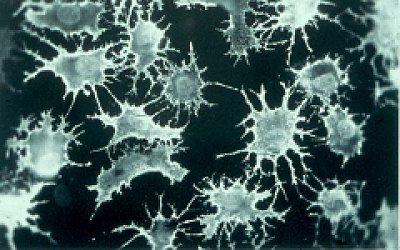Biology experiments
ACTIN
The role of weightlessness on actin metabolism in mammalian cells
This experiment aims to study the effect of weightlessness on the structure and metabolism of the protein actin in mammalian cells. Actin is an important molecule for cell shape and movement. It is also one of two proteins involved in muscle contraction and is found in both skeletal and non-skeletal muscle.

FLOW
Bone cell mechanosensitivity in weightlessness
In the bone formation process, bone cells called osteocytes produce certain signalling molecules that are responsible for maintaining bone health. Osteocytes produce these signalling molecules in response to stresses in bone under loading. The specific aim of this research is to test whether bone cells under weightlessness conditions have decreased sensitivity to stress by measuring the amount of signalling molecules they produce when stressed in space.
Osteocytes are the bone cells which are sensitive to mechanical stress. In this experiment, osteocytes will be compared to osteoblasts (bone forming cells) and periosteal fibroblasts (the cells found around bones from which connective tissue develops such as ligaments and tendons). Osteocytes, osteoblasts, and periosteal fibroblasts will be cultured with and without gravity. Gravity will be applied in the Soyuz TMA spacecraft using an onboard centrifuge.
Results from this experiment will provide further insight in the process of bone loss in space or on ground.

ICE-first
First International C.elegans Experiment : Physiological and genomic study of a nematode worm in space
ICE-first consists of several experiments, which will be investigating the effects of spaceflight on a model organism of the nematode family (Caenorhabditis elegans) and to develop links to human physiology in space. The organism chosen is known to be able to mate, reproduce and develop apparently normally during space flight.
One set of experiments will study the effect that radiation has on genetic stability. A second experiment is a study into muscle growth and endurance. The third experiment will do an analysis of almost the complete genome of the nematode worm in weightlessness to see which genes react differently in space than on Earth. The fourth experiment will study the development of nematode worm larvae in space. The last set experiment will try to determine if microtubules and microfilaments in specific cells of the nematode worm are sensitive to weightlessness.
KAPPA
The influence of weightlessness on the activation of the NF-ÊB (NF-kappaB) protein
NF-ÊB is a protein, which acts as a principal regulator of inflammation and immunity in the body. This experiment will study how NF-ÊB is transferred to the nucleus of a type of white blood cell called a monocyte, in weightlessness. It will further study the activation of a protein called I-ÊB, which inhibits the activity of NF-ÊB, and study the activation of several enzymes in weightlessness. The results obtained from this experiment may lead to more in-depth research, which could eventually provide the countermeasures to many illnesses suffered by humans on Earth.
TUBUL
Influence of gravity on the cytoskeleton and the determination of the division plane in plants
The cytoskeleton is an arrangement of fine tubules, microfilaments, and larger filaments within a cell, which serve to provide support to the cell’s structure, and to transport components from one part of the cell to another.
The cytoskeleton of plants, which consists of protein molecules arranged into chains, plays a crucial role in the orientation of the cell, the process of cell division and the direction of plant growth. This ultimately determines the plant's final shape and ultimately how well it functions as a complete organism. The TUBUL experiment aims at identifying the role that gravity plays in the organization and dynamics of the fine tubules (microtubuli) in living plant cells grown in space.

